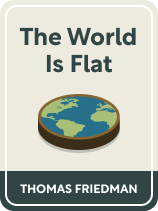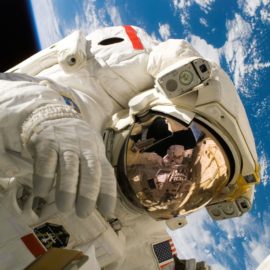

This article is an excerpt from the Shortform book guide to "The World Is Flat" by Thomas L. Friedman. Shortform has the world's best summaries and analyses of books you should be reading.
Like this article? Sign up for a free trial here.
What’s globalization? Is it good or bad? What can we do to benefit from it?
The World Is Flat by Thomas Friedman examines the causes, effects, and potential future of a globalized world. He argues that globalization is ultimately a good thing, and he offers recommendations on how governments and individuals can thrive even amid globalization’s challenges.
Continue reading for an overview of this thought-provoking book.
The World Is Flat by Thomas Friedman
Due mainly to technological advancements and changes in the political landscape, the world in the 21st century is now more connected than ever before, and more people than ever have access to the same information and opportunities. In other words, the world is becoming flat. Because of this, The World Is Flat by Thomas Friedman argues that individuals, companies, and countries must adapt quickly to the new global economy or risk falling behind.
Friedman has written extensively for The New York Times about foreign affairs and globalization. For The World Is Flat, published in 2005, Friedman traveled around the world, interviewing business executives, entrepreneurs, and politicians about the rapid changes occurring in the world and the instability such changes bring.
We’ll explore Friedman’s discussion of the leading causes of modern globalization and how they converged at the turn of the 21st century to change virtually every aspect of society. We’ll lay out his argument that globalization, despite its potential dangers, benefits the world and its inhabitants. Then, we’ll present his advice on how governments and individuals can best navigate the challenges of globalization.
Brief History of Globalization
Friedman breaks down the history of globalization into three periods:
The Period of Nations (1492-1800): In this era, powerful nations and governments drove globalization. Western European nations such as Great Britain, Portugal, and Spain, did most of the work, as they sought to journey across the world to advance their empires and trade globally.
The Period of International Companies (1800-2000): In this period, large, multinational corporations drove globalization. With the Industrial Revolution in full swing, companies were able to expand globally in search of new markets and labor. The combination of accessible trade and communication led to an economy in which companies could take advantage of global opportunities.
The Period of Individuals (2000-present): People now have the ability to communicate, collaborate, and compete with others globally. Thus, the top-down, hierarchical structures that controlled the world to this point are giving way to decentralized, crowd-sourced systems.
Political Changes Flattened the World
According to Friedman, the political change that initiated the process of globalization was the fall of the Berlin Wall on November 9, 1989. This event marked the end of the Cold War, a victory of capitalism and free markets over communism and government-run economies. This then encouraged the rest of the world to also adopt free-market strategies. Within a decade, countries like India, China, and Brazil moved away from centralized economies, adopted more democratic systems, and joined the global marketplace. As more governments embraced a free market, globalization flourished.
Technological Changes Flattened the World
Friedman argues that technological advancements helped put globalization into overdrive because people and businesses from around the world could now collaborate and trade hyper-efficiently. Once PCs became widespread and the internet, the web, web browsers, and web protocols were widely adopted, people and businesses could create, share, and work together from all corners of the world.
Search Engines Flattened the World
The development of search engines greatly enhanced people’s ability not only to inform themselves but to collaborate on a much larger scale. Search engines level the global playing field perhaps more than anything else because they open up a world of possibilities to billions of people.
Outsourcing and Offshoring Flattened the World
Friedman explains that, when the world became connected by the internet, the outsourcing of jobs grew cheaper because communicating and collaborating over long distances became easier. Globalization also accelerated offshoring, which is a little different from outsourcing. Instead of allowing a third party to help with a function or process of a company, offshoring sends in-house jobs overseas. The most prominent example of this is the common practice of sending manufacturing jobs to China.
Cheap goods made in China have saved the American consumer hundreds of billions of dollars. In addition, American companies have seen increased profits because of the practice, which allows them to grow their businesses and hire more workers in the U.S.
Global Supply Chains Flattened the World
When the world began collaborating on a global scale, businesses began using parts and products from all over to save costs, thereby creating global supply chains. Friedman says these drive globalization even further because they encourage companies from different countries to work together and adopt common business practices. They also discourage global conflict.
The World Became Flattest at the Turn of the 21st Century
Friedman argues that, around the year 2000, these forces of globalization—political change, technological advancements, and collaborative business practices—coalesced and began reinforcing each other in life-altering ways.
How America Can Thrive in a Globalized World
America has all the tools necessary to thrive in a global economy. If it wishes to do so, it must focus on three things: education, government policies, and infrastructure.
Education
People need to have the right knowledge and skills to find jobs and provide value to society. A large and thriving middle class is important for economic and political stability, so the U.S. needs to educate its citizens to find good middle-class jobs.
However, many of the middle-class jobs people relied on in the past will no longer exist in the flat world. They’ll be automated, outsourced, or simply obsolete. There is no way to know exactly how these jobs will change in the future, so Friedman provides three general tips on how the U.S. can best educate its young:
- Teach kids how to adapt.
- Teach kids how to properly navigate technology.
- Teach kids how to make mental connections between different areas of knowledge and expertise (math, science, and liberal arts), leading to innovation.
Government Regulation
Friedman argues that, to thrive in a flat world, the U.S. must find the right balance between free trade and governmental regulation. If it tries to insulate itself from globalization, it runs the risk of losing major ground to its global competition. But, doing nothing to protect its citizens from the potential downsides of globalization is also dangerous.
Friedman argues that trying to stop the outsourcing or automation of jobs will only delay the inevitable and hurt the U.S. in the process. The key is to make sure people are properly educated to take advantage of the opportunities.
To keep pace with globalization, Friedman argues that the U.S. needs fair and balanced tax policies that support businesses and the working middle class.
According to Friedman, to succeed in the flat world, America should also figure out how to properly regulate intellectual property. Such regulation must strike a balance in a way that protects ideas but also encourages innovators to share these ideas.
Infrastructure
According to Friedman, the U.S. needs to make sure its internet services and technology remain strong in the 21st century. Also, maintaining the strength of America’s robust network of research and science institutions will be vital to success in the flat world.
How You Can Thrive in a Flat World
Friedman argues that you must come to terms with the way the world is changing, and focus on how you can add unique value to society. Identify which jobs will be available and figure out the skills and knowledge you need to attain them. The valuable skills in a flat world fall into these broad categories: cooperation, integration, and versatility.
Cooperation: In a world in which international collaboration is becoming the norm, working well with others will make you irreplaceable.
Integration: You should integrate knowledge and expertise in two or more different areas or skill sets.
Versatility: If you can quickly adapt, take on new roles, and provide value in multiple ways, you’ll be irreplaceable.

———End of Preview———
Like what you just read? Read the rest of the world's best book summary and analysis of Thomas L. Friedman's "The World Is Flat" at Shortform.
Here's what you'll find in our full The World Is Flat summary:
- How the world is becoming one globalized society
- The potential costs and benefits of a flatter world
- How you can best contribute to a globalized society






